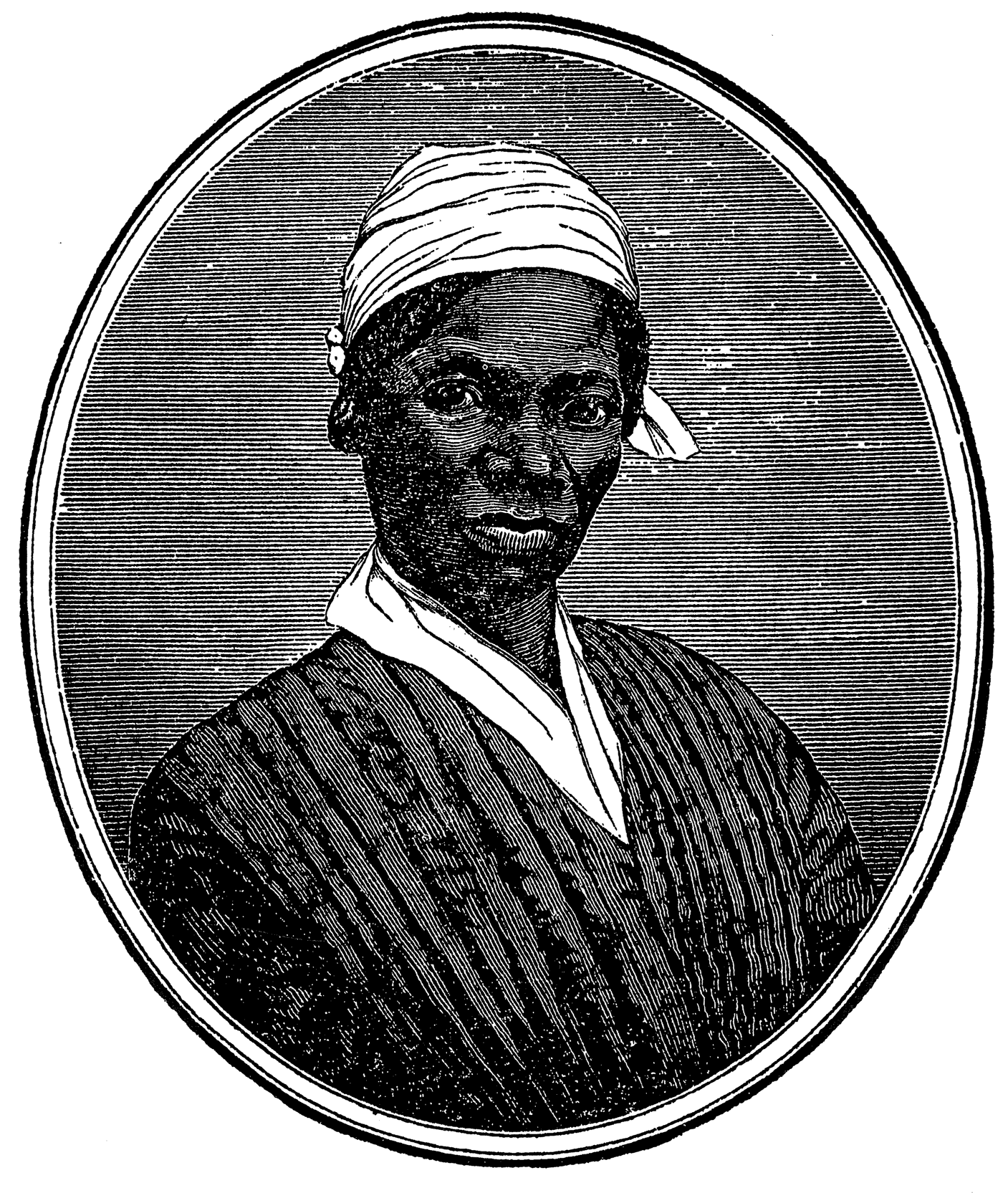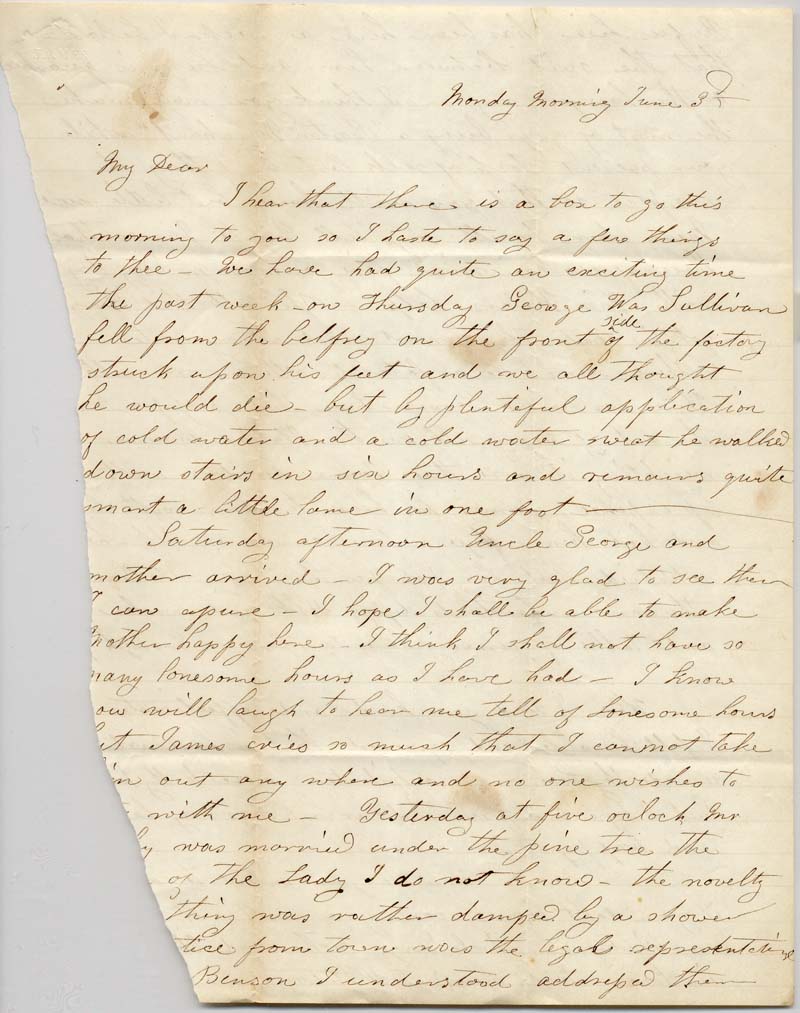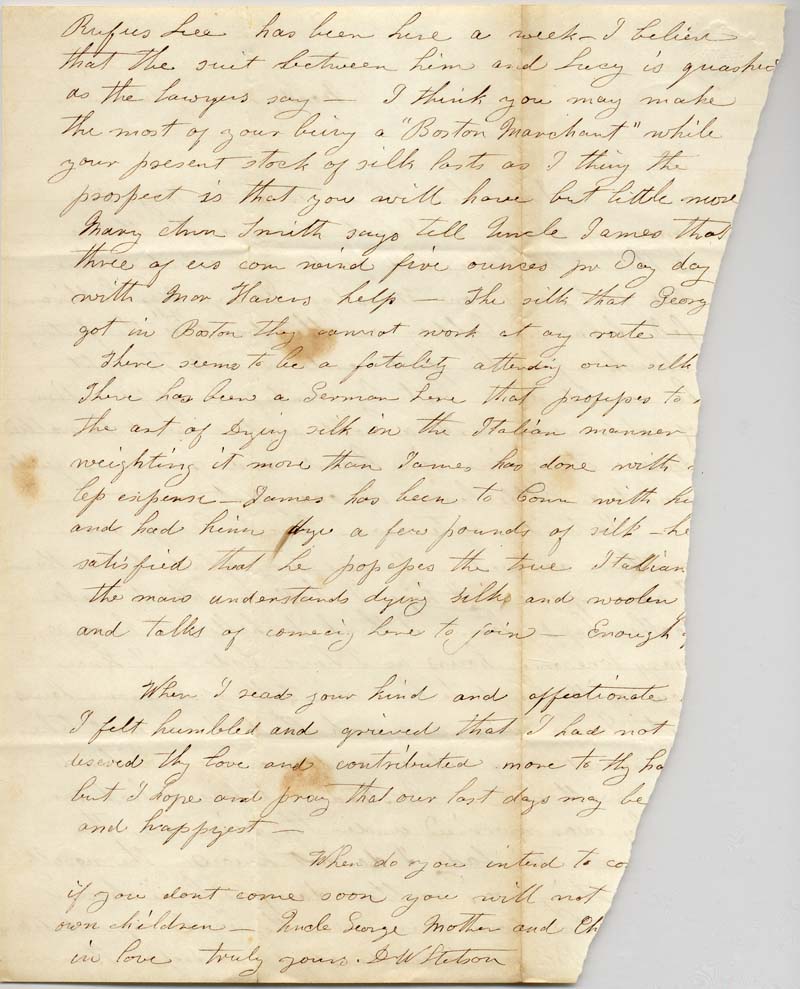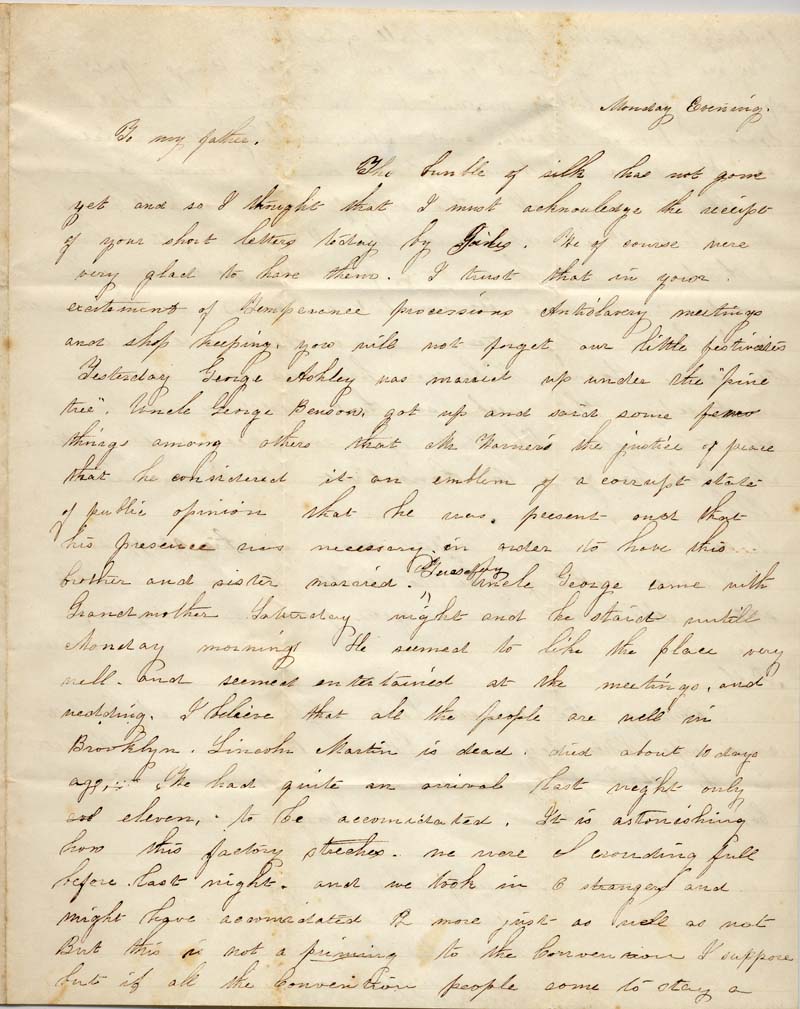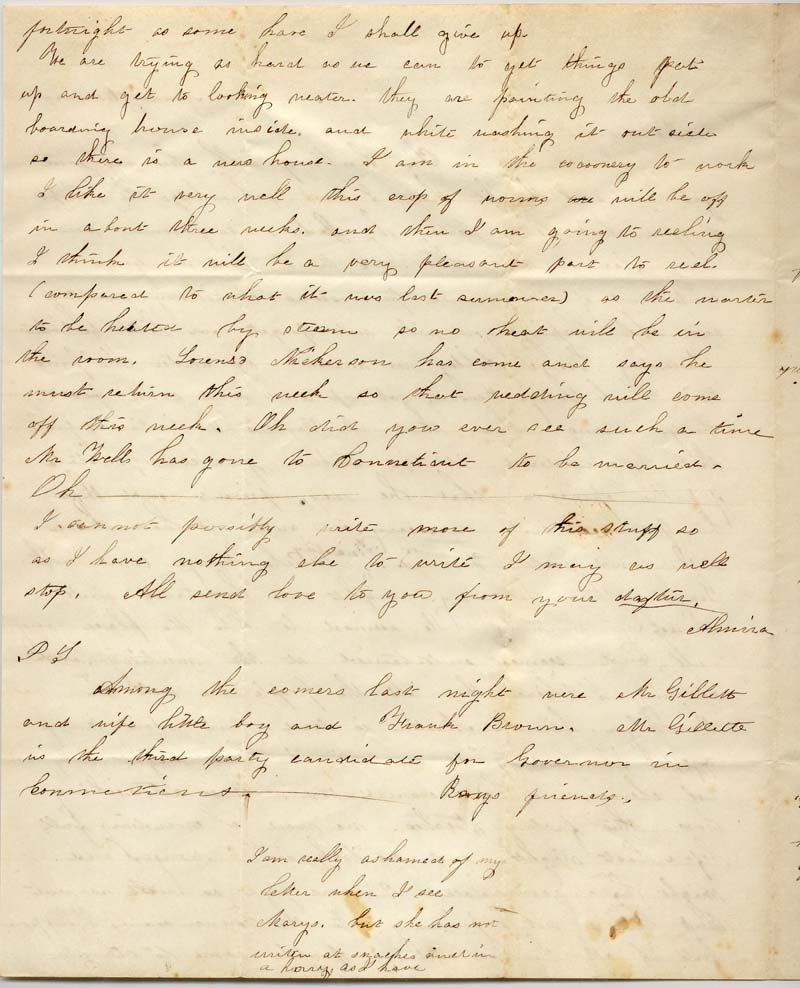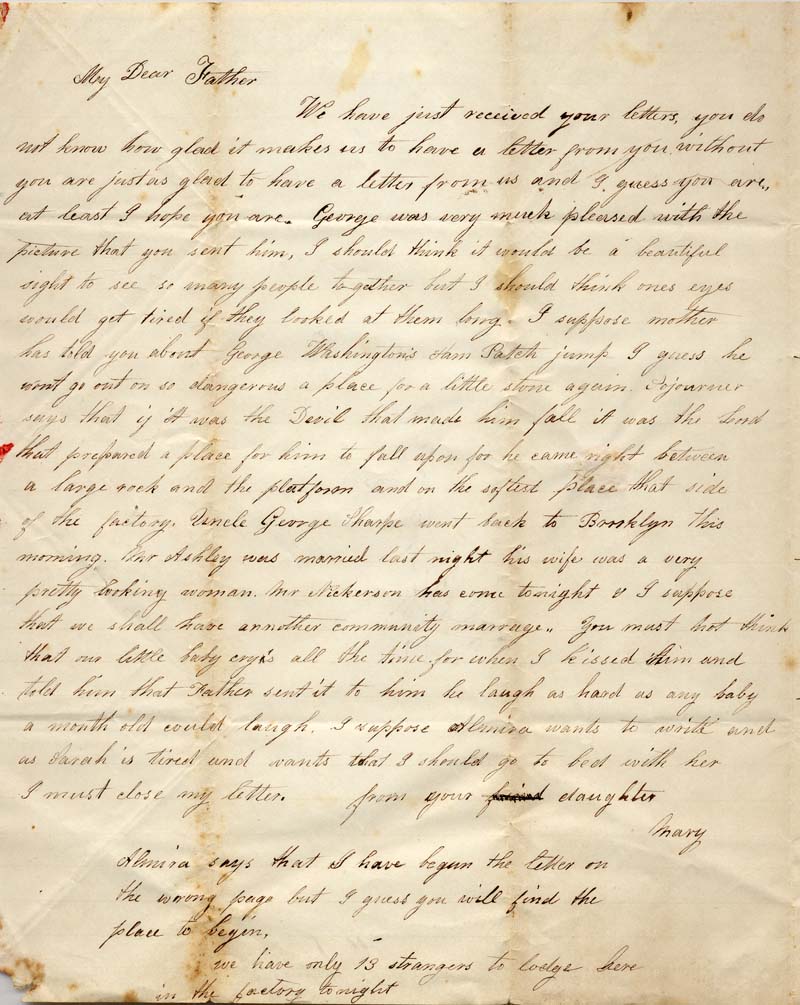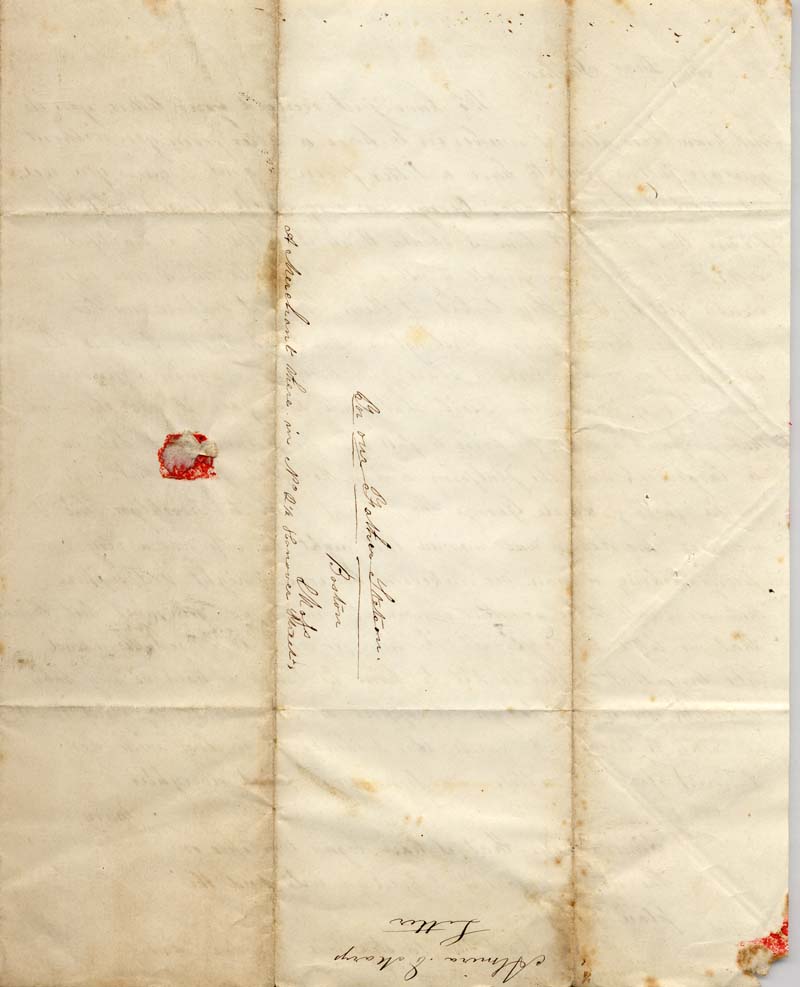Transcript:
[June 3, 1844]
My Dear
I hear that there is a box to go this morning to you so I haste to say a few things to thee – we have had quite an exciting time the past week – on Thursday George Was Sullivan fell from the belfrey on the front side of the factory struck upon his feet and we all thought he would die- but by plentiful application of cold water and a cold water sweat he walked down stairs in six hours and remains quite [s]mart a little lame in one foot —1
Saturday afternoon Uncle George2 and mother arrived – I was very glad to see them I can assure – I hope I shall be able to make Mother happy here – I think I shall not have so/// many lonesome hours as I have had – I know/// [y]ou will laugh to hear me tell of lonesome hours/// [bu]t James cries so much that I cannot take/// [hi]m out any where and no one wishes to///[ ? ] with me – Yesterday at five oclock Mr/// [Ashley] was married under the pine tree the/// [name?] of the Lady I do not know – the novelty/// [of the] thing was rather damped by a shower/// [Mr. Warner jus]tice from town was the legal representative/// [ ? ] Benson I understood addressed them3
Rufus Lee has been here a week – I believe that the suit between him and Lucy is quashed as the lawyers say4 — I think you may make the most of your being a “Boston Marchant” while your present stock of silk lasts as I [think?] the prospect is that you will have but little more/// [ … ] Mary Ann Smith says tell Uncle James that three of us can wind five ounces per Day day with Mr Havens help — The silk that Georg///[e] got in Boston they cannot work at any rate —5
There seems to be a fatality attending our silk/// [ … ] There has been a German here that professes to/// [ … ] the art of Dying silk in the Italian manner/// [ … ] weighting it more than James has done with/// [ … ] less expense – James has been to Conn with hi///[m?] and had him dye a few pounds of silk – he/// [is?] satisfied that he possesses the true Italian/// [ … ] the man understands dying silks and woolen/// [ … ] and talks of comeing here to join6 – Enough/// [ ]
When I read your kind and affectionate/// [letter?] I felt humbled and grieved that I had not/// [ … ] deseved thy love and contributed more to thy ha///[ppiness?] but I hope and pray that our last days may be///[ … ] and happyest –
When do you intend to co///[me home?] if you dont come soon you will not/// [know your?] own children – Uncle George Mother and Ch/// [ ? ] in love truly yours. DW Stetson
8. Almira B. Stetson and Mary Stetson to James A. Stetson
Monday Evening.
[June 3, 1844]
To my father,
The bundle of silk has not gone yet and so I thought that I must acknowledge the receipt of your short letters today by Giles.7 We of course were very glad to have them. I trust that in your excitement of Temperance processions Antislavery meetings and shop keeping, you will not forget our little festiveitis Yesterday George Ashley was married up under the “pine tree”. Uncle George Benson, got up and said some few things among others that Mr Warner’s the justice of peace that he considered it an emblem of a corrupt state of public opinion that he was present and that his presence was necessary in order to have this brother and sister married. Tuesday Uncle George8 came with Grandmother Saturday night and he staid untill Monday morning He seemed to like the place very well, and seemed entertained at the meetings, and wedding. I believe that all the people are well in Brooklyn. Lincoln Martin is dead. died about 10 days ago. We had quite an arrival last night only evl eleven, to be accomidated. It is astonishing how this factory streches. we were crouding full before last night, and we took in 6 strangers and might have accomidated 12 more just as well as not But this is not a priming to the Convention I suppose but if all the Convention people come to stay a fortnight as some have I shall give up.9
We are trying as hard as we can to get things put up and get to looking neater. they are painting the old boarding house inside and white washing it out side so there is a new house. I am in the cocoonery to work I like it very well this crop of worms are will be off in about three weeks. and then I am going to reeling I think it will be a very pleasant part to reel, (compared to what it was last summer) as the warter to be heated by steam so no heat will be in the room. Lorenso Nickerson has come and says he must return this week so that wedding will come off this week.10 Oh did you ever see such a time Mr Wells has gone to Conneticut to be married.11 Oh ———————————
I can not possibly write more of this stuff so as I have nothing else to write I may as well stop. All send love to you from your daftur,
Almira
P S
Among the comers last night were Mr Gillett and wife little boy and Frank Brown. Mr Gillette is the third party candidate for Governor in Conneticut — Roxys friends.
I am really ashamed of my letter when I see Marys. but she has not writen at snaches and in a hurry, as I have
My Dear Father
We have just received your letters, you do not know how glad it makes us to have a letter from you without you are just as glad to have a letter from us and I guess you are, at least I hope you are. George was very much pleased with the picture that you sent him, I should think it would be a beautiful sight to see so many people together but I should think ones eyes would get tired if they looked at them long. I suppose mother has told you about George Washington’s Sam Patch jump I guess he wont go out on so dangerous a place for a little stone again. Sojourner says that if it was the Devil that made him fall it was the Lord that prepared a place for him to fall upon for he came right between a large rock and the platform and on the softest place that side of the factory.12 Uncle George Sharpe went back to Brooklyn this morning. Mr Ashley was married last night his wife was a very pretty looking woman. Mr Nickerson has come tonight & I suppose that we shall have annother community marrage.. You must not think that our little baby crye’s all the time for when I kissed him and told him that Father sent it to him he laugh as hard as any baby a month old could laugh. I suppose Almira wants to write and as Sarah is tired and wants that I should go to bed with her I must close my letter. from your friend daughter
Mary
Almira says that I have begun the letter on the wrong page but I guess you will find the place to begin,
we have only 13 strangers to lodge here in the factory to night
Addressed: For our Father Stetson. / Boston / Mass / A Merchant there in No 2 1/2 Hanover Street.
Notes
- George Washington Sullivan (c.1825- ), from Baltimore, who may have been a former slave, lived at the NAEI from November 1843 until about July 1844; see Dolly W. Stetson to James A. Stetson, July 26, 1844 (letter no. 13) for David Ruggles’ comment on him. The Hampshire Gazette (Northampton), June 4, 1844, reported the “colored man” Sullivan’s fall from the factory roof. An entry in NAEI Records, vol. 1, p. 78 gives Sullivan’s birthdate as July 4, 1825; possibly he chose this date to symbolize his own new-found independence.
- This is Dolly Stetson’s uncle George Sharpe, of Abington, part of the town of Pomfret, Connecticut.
- George Ashley (see note 33) married Eliza Forward (1821-1855) on Sunday June 2, 1844.
Nonresistants, like Quakers before them, denied the necessity for a clergyman or civil officer to officiate at a marriage. The Liberator, June 14, 1844, reported that Ashley’s marriage, “though not wholly divested from the interference of the State, was nevertheless an interesting one.” Members of the community assembled under the great pine tree in the grounds, “their summer church.” In his speech George W. Benson explained that the parties had come “for the purpose of making a public acknowledgement of their union in marriage.” Marriage was “an institution of heaven,” and no human action was needed to bring it about because the couple were “already married” by the will of God. Though he avowed no disrespect to the justice of the peace, Oliver Warner, human intermeddling was merely “usurping a prerogative of the Deity.” Warner then “in the briefest way” obtained “the customary pledge of fidelity,” and pronounced Ashley and Forward legally married.
On this and several subsequent occasions couples marrying at the NAEI accepted Warner’s presence on sufferance, either to placate their own relatives or to avoid the imputation of sexual impropriety. See Christopher Clark, “ ‘We Might be Happyer Here’,” in this volume. When Warner had married NAEI members Hall and Frances Judd in 1842 at Judd’s parents’ house in Northampton, he had, according to Judd’s father, “obtained from each a promise to perform their conjugal duties, and pronounced them husband and wife. The time occupied was not over a minute. … There was no eating or drinking connected with this marriage. Mr Warner refused his fee, so it cost nothing to anybody.” (Sylvester Judd, “Notebook,” vol. 2, Judd Manuscript, Forbes Library, Northampton, Mass., entry for June 1, 1842). - Lucy Richardson (1825- ) was a daughter of James Stetson’s sister Nancy Richardson and had been at the NAEI since October 1842.
- Mary Ann Smith (1825- ), had come to the NAEI from Bloomfield, Conn., in January 1843 and worked mainly at silk production. She had ties to various abolitionist families and groups in Connecticut.
William Haven (1800-1866) had moved to the NAEI in May 1843 with his wife Louisa Ann Haven (1802/3-1889) and their seven children, then aged from sixteen down to two years. The Havens had previously lived in Windham, Conn., where William had superintended a cotton mill controlled by Samuel L. Hill, and where in 1836 he had helped Hill and others form the Willimantic Male Anti-Slavery Society. The Havens remained at Northampton after the NAEI disbanded in 1846. - James D. Atkins (1817/8-1896) had come to the NAEI in September 1842 from Cambridge, Mass., where he had been a stereotyper at the university printing press. He was given training and became the NAEI’s silk-dyer, remaining in the community throughout its existence.
The German dyer may have been the L. H. Plouquet or Ploucquet, referred to in letter no. 27. - Giles Badger Stebbins (1817-1900) lived at the NAEI from July 1843 to August 1844; he was not a member, but was studying with William Adam and David Mack. He was a nephew of Calvin Stebbins (see note 56), with whose family the Stetsons had shared a house when they first lived at the NAEI. For his recollections of the community, and of Dolly Stetson, see Giles B. Stebbins, “A Young Man in the Community,” in Sheffeld, ed., The History of Florence, p. 128; and Giles B. Stebbins, Upward Steps of Seventy Years (New York, 1890), p. 62.
- George Sharpe; see note 39.
- On the convention of Massachusetts communities for which guests were arriving, see below, note 54.
- On the marriage of Lorenzo Nickerson and Roxcy Brown, see note 33.
- Hiram Wells (see note 32) had been widowed in April 1843 and was marrying for the second time. The loss of his wife and a serious injury in an accident at work had produced much sympathy for him.
- On George Sullivan’s fall, see note 38. (Sam Patch [1799-1829] had been known as a youth in Pawtucket, R.I., for his jumps into the Blackstone River from a four-storey mill building, but between 1827 and 1829 had attained national national fame for his daredevil feats. Patch drowned in November 1829 after making a 125-foot jump into the Genesee River at Rochester, N.Y.).
Sojourner Truth (c.1797-1883), born into slavery in New York State, had moved to New York City after gaining freedom in 1827 and joined evangelical churches and an earlier communal movement. Having spent much of 1843 as an itinerant preacher, she came to the NAEI late that year and remained with the community for the rest of its existence. See Narrative of Sojourner Truth [1850], ed. Margaret Washington (New York, 1993), pp. 69-76; Carleton Mabee, Sojourner Truth: Slave, Prophet, Legend (New York, 1993), chapter 3; Paul E. Johnson and Sean Wilentz, The Kingdom of Matthias (New York, 1994), and especially Nell Irvin Painter, Sojourner Truth: A Life, A Symbol (New York, 1996), chapters 7-10. Her pithy remarks and paradoxes were among the things that Sojourner Truth would be remembered for; from this and other examples it appears that the Stetson children were collectors of her sayings. Fifty years later George R. Stetson would retell this and another of Sojourner’s remarks in his memoir of life at the NAEI, “When I Was a Boy,” in Sheffeld, ed., The History of Florence, p. 121.

